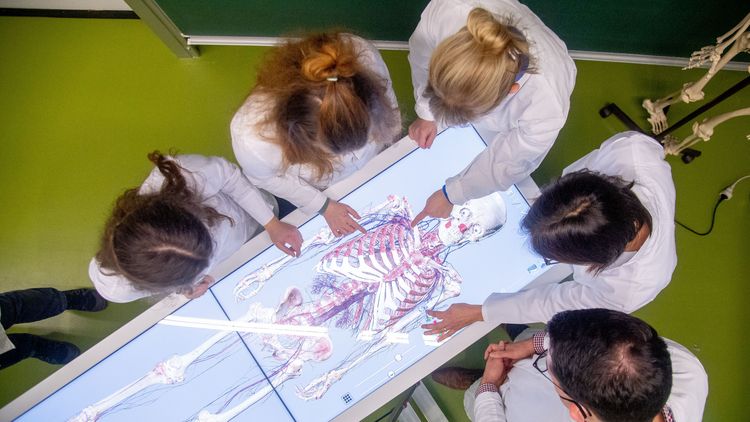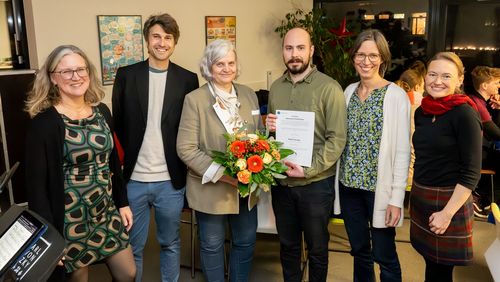Next winter semester, 120 new medical students will begin their studies at the University of Oldenburg, before only 80 students were accepted. The preparations are in full swing, and time is tight.
There's a lot of banging and noise on the ground floor of Building A3. The carpentry workshop that used to be there was relocated last year, and the neighbouring metalworking shop has also disappeared. A construction crew is now tearing down walls and turning the former workshops into modern microscopy rooms. Sixty-four new workstations which will be used mainly by medical students are being created here.
"We have to have it ready by the start of the winter semester," says Carsten Steinbrenner, head of space and construction planning at the university's Building Management Department. Normally he and his team try to stay one step ahead of the developments with their planning. In this case, however, they were overtaken by events.
Task force to prepare for incoming students
Back in the summer of 2021 it seemed clear that the plans to increase the number of places for new medical students from 80 to 120 would be postponed, because the government of the state of Lower Saxony had not included the necessary funds for the expansion in its draft budget. But disappointment was followed by delight in mid-November when the state parliament approved funds of 10.8 million euros per year for the project in its 2022/2023 budget, thus paving the way for 120 study places per year as of the coming winter semester.
Since then, the preparations have been in full swing to ensure that everything is ready when, for the first time ever, 120 first-semester medical students arrive on campus in October. "We have set up a task force at the Dean's Office," says teaching coordinator Stephanie Baszczok. Led by Prof. Dr. Hans Gerd Nothwang, Dean of Faculty VI Medicine and Health Sciences, and Prof. Karsten Witt, Dean of Academic Affairs, the team is planning all the necessary steps. Baszczok's most pressing task now is to organize the class schedules of 120 first-year medical students.
In the pilot study programme Human Medicine, this task is particularly challenging because the content alternates between theoretical and practical throughout the semester. Baszczok and her colleagues must recruit qualified lecturers who are very short on time due to their work as physicians, plan for varying group sizes, schedule practical laboratory training sessions and coordinate the space requirements.
But the university's high teaching standards are not the only factor complicating the planning. Nationwide medical licensing regulations and other provisions also impose constraints such as limits on the number of students allowed in a seminar, lesson or small group. More students means more small groups, which in turn means increased staffing and space requirements.
Clinical Training Centre with new rooms
But at least the task force is not starting from scratch with its planning. When the number of study places was raised to 80 three years ago, increasing that figure to 120 was already under consideration. "Now we need to check with everyone involved that the plans are still realistic and then implement them," says Baszczok.
The new rooms at the Clinical Training Centre (KTZ) are almost ready for use. In Building V02, the area where students acquire practical skills in recreated doctors' offices using various models and simulators has almost doubled in size.
"Fifty percent more students all of a sudden – that's quite a challenge," says Dr Katrin Wüstenbecker, Medical Director of the KTZ. But things were already getting cramped with 80 students in the old rooms, so she's glad that the extension is now almost complete. The team is still waiting for the last pieces of equipment, which should arrive in time for the winter semester despite delivery problems.
"We are delighted to be able to train more medical professionals, which the region so urgently needs," says Dean Nothwang. At the same time he is aware of the challenges posed by the tight deadline: "Many people are doing their utmost behind the scenes to ensure that the new students have a successful start with us in the autumn. My special thanks go to them."
The School of Medicine and Health Sciences will continue to expand after 2022 – also in terms of its facilities. The construction of a research building complex including a much-needed wet anatomy lab is already under way on Oldenburg's Pophankenweg. Currently, Oldenburg students have to travel to Groningen for these practical anatomy training sessions. There are also plans to increase the number of new students to 200 per year in the not too distant future.






